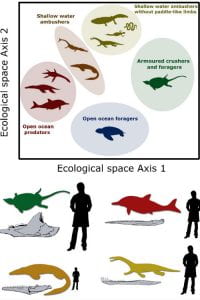Jane’s MSc project on ‘Evolution of ecospace occupancy by Mesozoic marine tetrapods’ has just been published in Palaeontology, and you can read it here. In her study, Jane reviewed all the ichthyosaur, plesiosaurs and other toothy monsters of the Mesozoic seas, and determined their body sizes, diets (fishes, molluscs, each other), swimming styles, as well as their stratigraphic ranges. In previous studies, researchers had determined guilds (= ecological groupings that share modes of life) either on diet or locomotion, but here she combined all aspects of ecology that could be determined reasonably reliably. She coded 35 ecological traits for 371 species (work out how many cells in the data table!).
 The multivariate numerical analysis showed that all these marine reptiles could be divided into just six ecological categories linking how they moved, where they lived, and how they fed: pursuit predators that chased their prey, ambush predators that lurked and waited for the prey to swim past (two groups, one in deep water, one in shallow), a fourth group of reptiles that could still walk on land, shallow-water shell-crushers and foragers, and marine turtles with a variety of life modes.
The multivariate numerical analysis showed that all these marine reptiles could be divided into just six ecological categories linking how they moved, where they lived, and how they fed: pursuit predators that chased their prey, ambush predators that lurked and waited for the prey to swim past (two groups, one in deep water, one in shallow), a fourth group of reptiles that could still walk on land, shallow-water shell-crushers and foragers, and marine turtles with a variety of life modes.
Jane then looked at how the different guilds responded to mass extinctions, such as that at the end of the Triassic, and confirmed the huge extinction and replacement by new clades. However, the surviving ichthyosaurs and plesiosaurs showed considerable conservatism. They didn’t expand their ecological roles at all, and many niches were left empty until new groups of crocodiles and turtles emerged later in the Jurassic to take over these roles.
 Jane Reeves added: “It was a great experience being able to study a large variety of creatures, and to then reconstruct the ecological lifestyles of extinct animals from just their fossils”. She is now doing a NERC-funded PhD on ‘The soft tissue fossil record to elucidate the origin and diversification of vertebrates’ at the University of Manchester.
Jane Reeves added: “It was a great experience being able to study a large variety of creatures, and to then reconstruct the ecological lifestyles of extinct animals from just their fossils”. She is now doing a NERC-funded PhD on ‘The soft tissue fossil record to elucidate the origin and diversification of vertebrates’ at the University of Manchester.
You can read the University of Bristol press release here.

